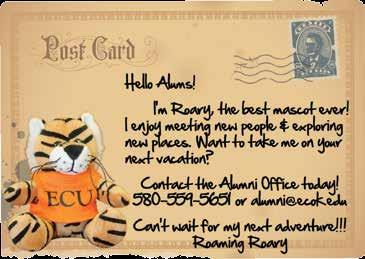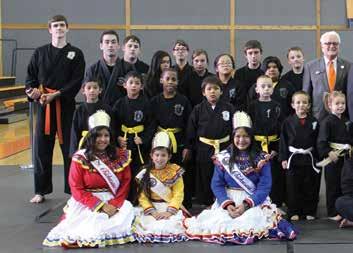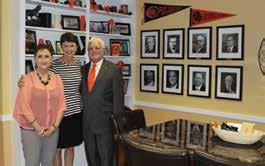
6 minute read
Dr. Raniyah Ramadan CURL
CURL Grand Opening
NEW DR. RANIYAH RAMADAN CENTER FOR UNDERGRADUATE RESEARCH and LEARNING TO ULTIMATELY BENEFIT ENTIRE ECU CAMPUS
Advertisement
A new era was ushered into the learning environment at East Central University with the grand opening of the Dr. Raniyah Ramadan Center for Undergraduate Research and Learning on April 24.
The state-of-the art facility, located on the lower east end of ECU’s Education Building, features two laboratories for biology and one each for chemistry and environmental health science, in addition to a refrigerated storage area for microbacteria and a conference room.
Dr. Raniyah Ramadan was a promising research scientist who grew up in Ada and passed away in July 2011. The Dr. Raniyah Ramadan Foundation was established by her parents, Dr. Tawfik and Siham Ramadan, and her sisters and brother to keep her memory alive and establish scholarships in neuroscience
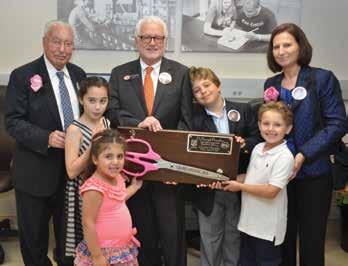
ECU President John R. Hargrave (center) poses with Dr. Tawfik Ramadan (left) and family with the ceremonial ribbon-cutting scissors.
research and cancer research.
After graduating from Ada High School, Ramadan earned a bachelor’s degree from the University of Oklahoma in 1998 as well as two degrees at the University of Oklahoma Health Sciences Center: a master’s degree in public health in 2000; and Ph.D. in neuroscience in 2007.
She was a graduate research assistant in biomedical sciences at the OU Health Sciences Center in Oklahoma City from 2001 to 2007 where she researched the pathogenic mechanisms of bacterial endophthalmitis. She authored and coauthored several articles for academic journals.
Ramadan was awarded a prestigious post-doctoral research fellowship in ophthalmology and visual sciences at Case Western Reserve University in Cleveland, Ohio. After completing the fellowship, she moved in 2008 to Regeneron Pharmaceuticals in New York where she worked on ocular disease models. She initiated the protocol for animal models of ocular inflammatory diseases that affect about two million Americans and also conducted the histology analysis for the company’s uveitis models in rats and mice.
“Approximately half of the College of Health and Sciences faculty will at some point be using the facility and we will have from 20 to 30 students involved in undergraduate research projects each year when we are at full capacity,” said Dr. Bruce Weems, recently retired dean of ECU’s College of Health and Sciences. “One of the CHS’s strategic long-term goals was to increase our capacity to do research for both faculty and our students.
--Dr. David Weir, director
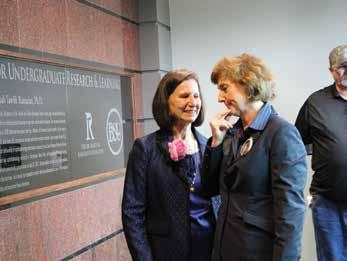
Siham Ramadan, mother of the late Dr. Raniyah Ramadan, speaks with State Senator Susan Paddack during grand opening festivities.
Tours were given of the Ramadan Center.
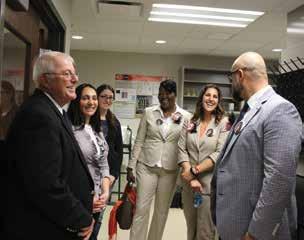
The opening of the Raniyah Ramadan Center for Undergraduate Research and Learning will finally accomplish that goal and set the stage for the college to accomplish many of these future goals for improving undergraduate research experiences for our students.”
With the completion of the facility, ECU will be the only Regional University System institution which has a dedicated center for undergraduate research.
“The fact that this is the only undergraduate research facility within the RUSO system, clearly shows the commitment of the ECU administration to the concept of integrating undergraduate research into all facets of the college experience for our students,” Weems said.
The facility was funded through the Native American Serving Non-Tribal
Members of the Ramadan family participate in the ribbon cutting ceremony.
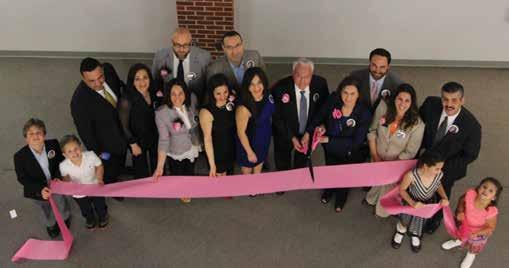
Institutions (NASNTI) Grant with the help of a major donation from the family of the late Dr. Raniyah Ramadan.
Dr. David Weir will serve as director of the Ramadan Center through the remaining two-year grant process and will ultimately become director for undergraduate research for the entire ECU campus.
Weir, who earned his bachelor’s and master’s degrees from Texas Tech University and his doctorate from Purdue University, knows firsthand the importance of undergraduate research after performing those duties in the discipline of history at Texas Tech.
“I feel strongly in the importance of research because of that previous experience. It allowed me to expand my own interest in my field of study and I got to see what faculty members do as researchers,” Weir said. “Tangibly, it was shown through a study at the University of Michigan that students who undergo undergraduate research are more likely to stay in school or graduate. They were significantly more likely to finish school and go on to pursue a graduate degree of any kind.”
Those retention possibilities are primarily made possible because of relationships built between the mentor (faculty member) and the student.
“I’m really excited. This is a great opportunity for our students and faculty to engage through research and mentorship settings,” Weir said. “This will allow students to get into research opportunities sooner than their junior or senior years.”


REGIONAL, STATE SCIENCE & ENGINEERING FAIRS AT ECU RECEIVE SUPPORT


For the second year in a row, the East Central Oklahoma Regional Science Fair and Oklahoma State Science and Engineering Fair were funded by the state of Oklahoma, thanks to the efforts of East Central University President John R. Hargrave along with Oklahoma State Sen. Susan Paddack and State Rep. Todd Thomsen.
The $100,000 grant doubled last year’s fund, which not only covered these two particular fairs hosted by ECU, but other local and regional fairs across the state.
“STEM (science, technology, engineering and mathematics) is vitally important to the education process of our youth and science fairs play a major role in the development of students’ learning and understanding of the world around them,” said Hargrave.
To go from $50,000 to $100,000 was important, due to the continual rise in the cost of living. The original $50,000 grant was provided each year through the 1980s and 1990s, until 2009 when the recession led to the cutting of many discretionary programs, including science fairs. Through the help of Hargrave, Paddack and Thomsen, the funding was reinstated in 2013 at $50,000.
“We had situations where some schools were struggling. Some parents were paying for everything. To have a little extra so it’s not coming out of the parents’ or even teachers’ pockets is important,’ said Dr. Rahmona Thompson, professor of biology and director of both science and engineering fairs at ECU. “We had a situation where a teacher went home and built several boards for his students at his own expense. With additional funding, we can use some money to reimburse them for their supply expenditures. Another allotment of the funds will be used for gas money.”
This money will also be applied for teachers’ training workshops before the regional fair, according to Thompson. Plus each regional fair will receive $5,000 to hold the fair and send projects to the international fair.
DID YOU KNOW? OK STATE SCIENCE FAIR BY THE NUMBERS 242 224 students presented projects. 40 entries in physical sciences category.
19 scholarships were awarded from ECU, Cameron, Connors State College, Northwestern Okla. State, Univ. of Central Okla., Tulsa Community College, Rogers State Univ. and Southwestern Okla. State Univ.
category awards were presented. 33 entries in biochemistry, medicine & health science category. 30 entries in behavioral & social sciences category.
13 entries in mathematics & computer science category. 30 entries in zoology & botany category. 12 entries in earth & space sciences category. 13 entries in microbiology category.
23 entries in engineering category. 30 entries in environmental sciences category.



